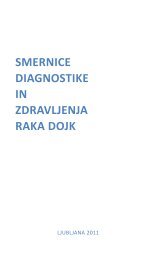You also want an ePaper? Increase the reach of your titles
YUMPU automatically turns print PDFs into web optimized ePapers that Google loves.
Optimization of electric pulse parameters for efficient<br />
electrically-assisted gene delivery into canine skeletal<br />
muscle<br />
Darja Pavlin 1 , Nata{a Tozon 1 , Gregor Ser{a 2 , Azra Poga~nik 1 ,<br />
Maja ^ema`ar 2<br />
1<br />
Veterinary Faculty, University of Ljubljana, Gerbi~eva 60, SI-Ljubljana; 2 Department of<br />
Experimental Oncology, Institute of Oncology, Zalo{ka 2, SI-Ljubljana<br />
Skeletal muscle is an attractive target tissue for delivery of therapeutic genes,<br />
since it is usually large mass of well vascularized and easily accessible tissue with<br />
high capacity for synthesis of proteins, which can be secreted either locally or<br />
systemically. Electrically-assisted gene delivery into skeletal muscle of a number<br />
of experimental animals has already been achieved using two different types of<br />
electroporation (EP) protocols. The first one utilized only low voltage electric pulses<br />
with long duration (e.g. 100-200 V/cm, 20-50 ms). Lately it has been shown, that<br />
better transfection efficiency can be achieved using combination of high voltage<br />
(HV) electric pulses (600-800 V/cm, 100 µs), which cause permeabilization of cell<br />
membrane, followed by low voltage (LV) electric pulses to enable electrophoresis<br />
of DNA across destabilized cell membrane.<br />
The aim of this study was to determine optimal EP protocol for delivery of plasmid<br />
DNA into canine skeletal muscle. For this purpose we injected 150 µg/150 µl of<br />
plasmid, encoding green fluorescence protein (GFP), intramusculary into m.<br />
semitendinosus of 6 beagle dogs. Electric pulses were delivered 20 minutes after<br />
plasmid injection, with electric pulses generator Cliniporator (IGEA, Carpi, Italy),<br />
using needle electrodes. Altogether 5 different EP protocols were utilized, each<br />
applied to two muscles. Three of these protocols utilized combination of one<br />
HV pulse (600 V/cm, 100 µs), followed by different number of LV pulses. Two<br />
protocols were performed by application of LV pulses only. The control group<br />
received only injection of plasmid without application of electric pulses. Incisional<br />
biopsies of transfected muscles were performed 2 and 7 days after the procedure<br />
and transfection efficiency was determined using fluorescence microscope on frozen<br />
muscle samples.<br />
100p28<br />
The highest level of GFP fluorescence in the muscle was observed in EP protocol,<br />
using either 1 HV pulse, followed by 4 LV pulses (80 V/cm, ms, 1Hz) or with 8<br />
LV pulses (200 V/cm, 20 ms, 1Hz). In both protocols significant GFP fluorescence<br />
was detectable both at 2 and 7 days after transfection. Markedly lower degree of<br />
transfection was achieved using EP protocol, utilizing 1 HV, followed by 8 LV (80<br />
V/cm, 400 ms, 1Hz). GFP fluorescence was less pronounced compared to the first<br />
two protocols. Furthermore, it was detectable only on muscle samples, taken at day<br />
2 after electrotransfection. No GFP fluorescence was detectable either at 2 or 7 days<br />
after electrotransfection on muscle samples, taken from control group and from<br />
groups, where 1 HV, followed by 1 LV (80 V/cm, 400 ms) or 6 LV pulses (100 V/cm,<br />
60 ms, 1Hz) were used.

















